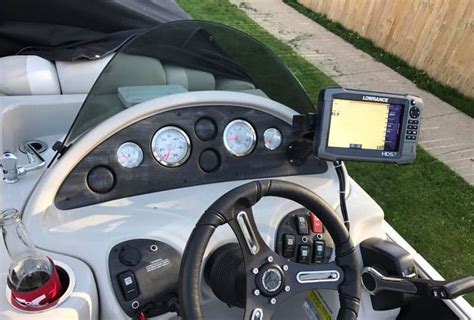How To Install Depth Finder On Pontoon Boat
Ronan Farrow
Apr 01, 2025 · 4 min read

Table of Contents
How to Install a Depth Finder on Your Pontoon Boat
Installing a depth finder on your pontoon boat can significantly enhance your fishing experience and overall safety on the water. This guide provides a step-by-step process for a successful installation, catering to different levels of experience. Remember, safety is paramount; if you're uncomfortable with any step, consult a marine professional.
Choosing Your Depth Finder and Mounting Location
Before you begin, you need to select a depth finder that meets your needs and budget. Consider factors such as:
- Display Size: Larger displays offer better visibility, especially in bright sunlight.
- Features: Do you need GPS, fish finding capabilities, or other advanced features?
- Transducer Type: Choose a transducer compatible with your pontoon's hull material (aluminum or fiberglass). Consider through-hull, transom mount, or even a trolling motor mount depending on your preference and boat setup.
Once you've selected your depth finder, choosing the right mounting location is crucial for optimal performance and visibility:
- Helm: This offers easy access and visibility while driving.
- Console: A good alternative for unobstructed visibility.
- Bow: Suitable if you frequently fish from the front of the boat.
Consider factors like sunlight glare, ease of access to wiring and the transducer, and potential obstructions before making your decision.
Tools and Materials You'll Need
Before you start, gather the necessary tools and materials:
- Your chosen depth finder unit: Ensure it's the correct model for your needs and boat.
- Transducer: This sends and receives sound waves to measure depth.
- Wiring Harness: This connects the depth finder to the power source and transducer.
- Drill: With appropriate drill bits for your chosen mounting location.
- Screws: For securing the depth finder unit and transducer.
- Marine-grade sealant: To prevent water ingress and corrosion.
- Wire strippers and crimpers: For connecting wires securely.
- Measuring tape and level: For accurate placement and installation.
- Wire ties and protective tubing: For organizing and protecting wires.
- Power source: Usually a 12V DC power source from your boat's battery.
- Circuit breaker or fuse: To protect your electrical system.
Step-by-Step Installation Guide
1. Preparing the Mounting Location
Carefully clean the area where you plan to mount the depth finder unit. Ensure the surface is level and free of any debris. If drilling is required, mark the location precisely using a template provided with your device or by carefully measuring and marking.
2. Mounting the Transducer
This step is heavily dependent on the transducer type you've chosen:
- Transom Mount: Follow the manufacturer's instructions carefully. Generally, this involves cleaning the transom, applying sealant, mounting the transducer and securing it with screws.
- Through-Hull Mount: This requires drilling a hole in the hull of your pontoon. This is a more involved process and may require professional assistance if you're not comfortable drilling into your boat's hull.
- Trolling Motor Mount: The transducer attaches to your trolling motor. This is typically a straightforward process, but refer to both your depth finder and trolling motor manuals for guidance.
3. Running the Wiring
Route the wiring neatly and securely from the transducer to the chosen mounting location of the depth finder unit. Use wire ties and protective tubing to keep the wires organized and protected from damage. Avoid running wires near sharp edges or moving parts.
4. Connecting the Wiring
Connect the wiring harness to the depth finder unit and the transducer, following the manufacturer's instructions carefully. Secure all connections using crimp connectors and marine-grade sealant to ensure watertight connections.
5. Mounting the Depth Finder Unit
Once the wiring is complete, mount the depth finder unit to the chosen location. Use a level to ensure it's perfectly level and secure it with the supplied screws.
6. Powering Up and Testing
Connect the depth finder to the boat's 12V DC power supply. Turn on the unit and test its functionality to verify the installation was done correctly. Make sure all functions are working correctly.
7. Final Checks
Conduct a final inspection to make sure all connections are secure, the wiring is neatly routed and protected, and the unit is functioning properly.
Troubleshooting
If your depth finder isn't functioning correctly, check the following:
- Power supply: Ensure the unit is receiving sufficient power.
- Connections: Check all connections for tightness and corrosion.
- Transducer: Ensure the transducer is properly installed and making good contact with the water.
- Manufacturer's instructions: Consult your depth finder's manual for troubleshooting guidance.
Installing a depth finder on your pontoon boat can be a rewarding project. By following these steps carefully and referring to the manufacturer’s instructions for your specific model, you can successfully improve your boating experience. Remember to prioritize safety and seek professional help if needed.
Featured Posts
Also read the following articles
| Article Title | Date |
|---|---|
| How To Make Pickle Moonshine | Apr 01, 2025 |
| How To Move Out Of State With Joint Custody | Apr 01, 2025 |
| How To Leverage Clubhouse For Networking | Apr 01, 2025 |
| How To Prepare For A 50 H Hearing | Apr 01, 2025 |
| How To Hunt Black Tail Deer | Apr 01, 2025 |
Latest Posts
Thank you for visiting our website which covers about How To Install Depth Finder On Pontoon Boat . We hope the information provided has been useful to you. Feel free to contact us if you have any questions or need further assistance. See you next time and don't miss to bookmark.
